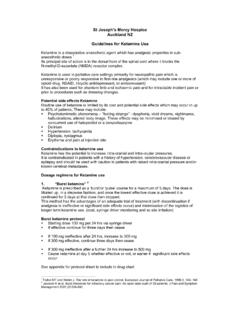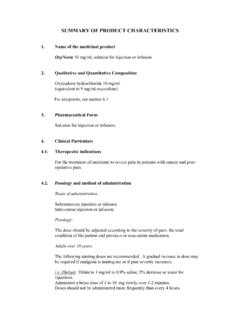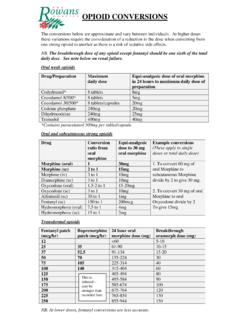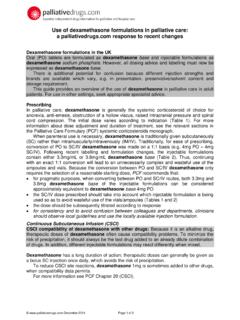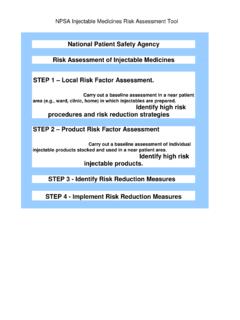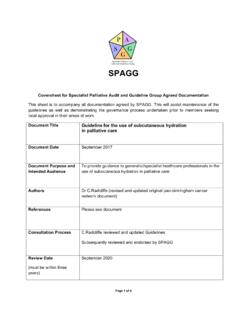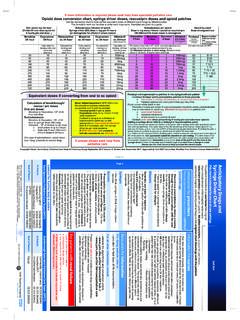Transcription of USE OF CORTICOSTEROIDS - palliativedrugs.com
1 ST. MICHAEL S HOSPICE CLINICAL CARE GUIDELINES USE OF CORTICOSTEROIDS ORIGINATOR: DR. EMMA HUSBANDS DATE : OCTOBER 2006 REVIEW DATE: OCTOBER 2008 DEFINITIONS AND PRINCIPLES CORTICOSTEROIDS are produced by the cortex of the adrenal glands(1). There are two main forms-glucocorticoids and mineralocorticoids(1). The actions of glucocorticoids include gluconeogenesis, fat deposition, sodium retention, decreased protein synthesis and decreased immune response(1). Examples of glucocorticoids include Cortisol (Hydrocortisone), Prednisolone and Dexamethasone(1).
2 Mineralocorticoids , such as Fludrocortisone, mainly act on the extracellular balance of sodium and potassium in the distal tubule of the kidney(1). Glucocorticoids are commonly used within palliative care in a variety of doses to tackle both specific and non-specific symptoms of advanced cancer(2). They are commonly referred to as steroids although as explained above they are one form of several CORTICOSTEROIDS (1). The corticosteroid used most commonly in palliative care is Dexamethasone, see below(3). The use of CORTICOSTEROIDS within the general medical population is extremely closely monitored and there have been some concerns within the literature that this is not appropriately translated into palliative care patients(4,5).
3 AIMS CORTICOSTEROIDS should be considered for various symptoms as outlined below with the aim of treatment being clear. Treatment should be regularly monitored and if symptoms do not respond, stop responding or recur, steroids should be reduced and withdrawn. CORTICOSTEROIDS have considerable side-effects and hence the LOWEST effective dose should be used. Reduce the dose of steroids to the minimum required to achieve symptomatic effect. The prognosis of the patient should be considered when prescribing steroids. Side-effects from steroids may be a problem for patients with a prognosis of months or more.
4 PHARMACOLOGY OF CORTICOSTEROIDS The corticosteroid of choice within palliative care is Dexamethasone but Prednisolone is used at times(3). Below is a table of approximate equivalencies of several CORTICOSTEROIDS (6). NAME DOSE (mg) DURATION OF ACTION (hrs) Hydrocortisone 20mg 8-12 Prednisolone 5mg 12-36 Dexamethasone 36-54 Dexamethasone has several advantages for patients with malignancy(6) a lower sodium retention potency and hence reduced likelihood of fluid retention ability to administer larger dose with small number of tablets.
5 Available as subcutaneous injection. SIDE EFFECTS Doses >4mg od are likely to lead to significant side effects after several weeks(3). Doses <4mg od are often tolerated in patients with a prognosis of months(3). Doses <4mg can be stopped abruptly IF used for less than 3weeks(3). Early effects days(6) Diabetes mellitus (steroid induced or worsening of established type1 or type 2 diabetes) Fluid retention Mental disturbance insomnia, agitation, euphoria, paranoia Later effects-weeks(6) Cushinghoid appearance moon facies, central obesity, buffalo hump.
6 Thinning of skin Increased susceptibility to infection especially oral thrush Additive risk of GI bleed when used with NSAIDS Proximal muscle wasting and weakness Longer term effects - months to years(6) Avascular bone necrosis Osteoporosis PRESCRIBING CORTICOSTEROIDS General Points Always clearly document reasons for prescribing steroids(4,6,7). Review treatment regularly and discontinue if no benefit after one week, ensure patients are aware of need to give short courses of steroids(6,7). Patients should be made aware of side-effects, need to report to GP or ward staff if less well on steroids(6,7).
7 Give steroids before midday to minimize risk of sleep disturbance(3). Give prophylactic gastric protection if also taking NSAIDS or consider if previous GI bleed(7). Consider prophylactic topical oral anti-fungals - Nystatin 1ml QDS, if any present or prior oral symptoms(5). Doses may need to be doubled if patients are also taking enzyme-inducers eg. Phenytoin, Carbamazepine(3). Consider switching to Prednisolone if proximal myopathy develops but benefit is still being achieved on Dexamethasone(3). Consider prophylaxis against osteoporosis (eg; Risendronate 35mg once weekly) if patient is on steroids for >6months(3).
8 Weekly urinalysis or monitoring of blood sugars, particularly if symptomatic(7). Reduction/Discontinuation(3) If taking <4mg Dexamethasone for less than 3 weeks, it is safe to stop steroids abruptly but likely to choose to gradually reduce dose in order to avoid recurrence of symptoms. If taking Dexamethasone for more than 3 weeks, gradual reduction according to suggested guidance and clinical judgement below must be followed as suppression of patient s hypothalamic/pituitary/adrenal axis will have occurred. o Suggested guidance for reducing dose: Dexamethasone>2mg daily reduce by 2mg every 5-7 days.
9 Then/or Dexamethasone <2mg daily reduce dose by every 5-7 days or on alternative days to stopping. Symptoms may occur on dose reduction Steroids at the End of Life There is a lack of evidence over discontinuation of steroids at the end of life and each case should be considered in terms of the reason for taking the steroids, dose and duration along with burden of administering the steroids either orally or subcutaneously. Ideally the decision should be discussed with the patient and/or relatives. Recommended Doses Below is a table with suggested average doses of dexamethasone(3,6,7) 2-4mg/day 4-8mg/day Up to 16mg/day Anorexia Weakness Improvement in well being/mood Non-specific pain relief Anti-emetic Co-analgesic in nerve compression pain liver capsule pain Raised intracranial pressure Spinal cord compression SVC obstruction Obstruction of hollow viscus - bronchus - bowel - ureter Anorexia(1,3,6,7) Is a universal symptom in the dying - often this concerns carers more than the patient.
10 Careful discussion and reassurance that deterioration in condition is due to disease process can relieve anxieties about limited food intake. If the patient is concerned about poor intake, it may be appropriate to have a trial of steroid therapy. If the patient has no appetite undue pressure to eat will cause distress and or nausea. Appetite / wellbeing(1,3,6,7) Steroids can increase appetite, food intake and sense of wellbeing, although this is usually a short term benefit. If appetite not improved steroids should be rapidly tailed off.
